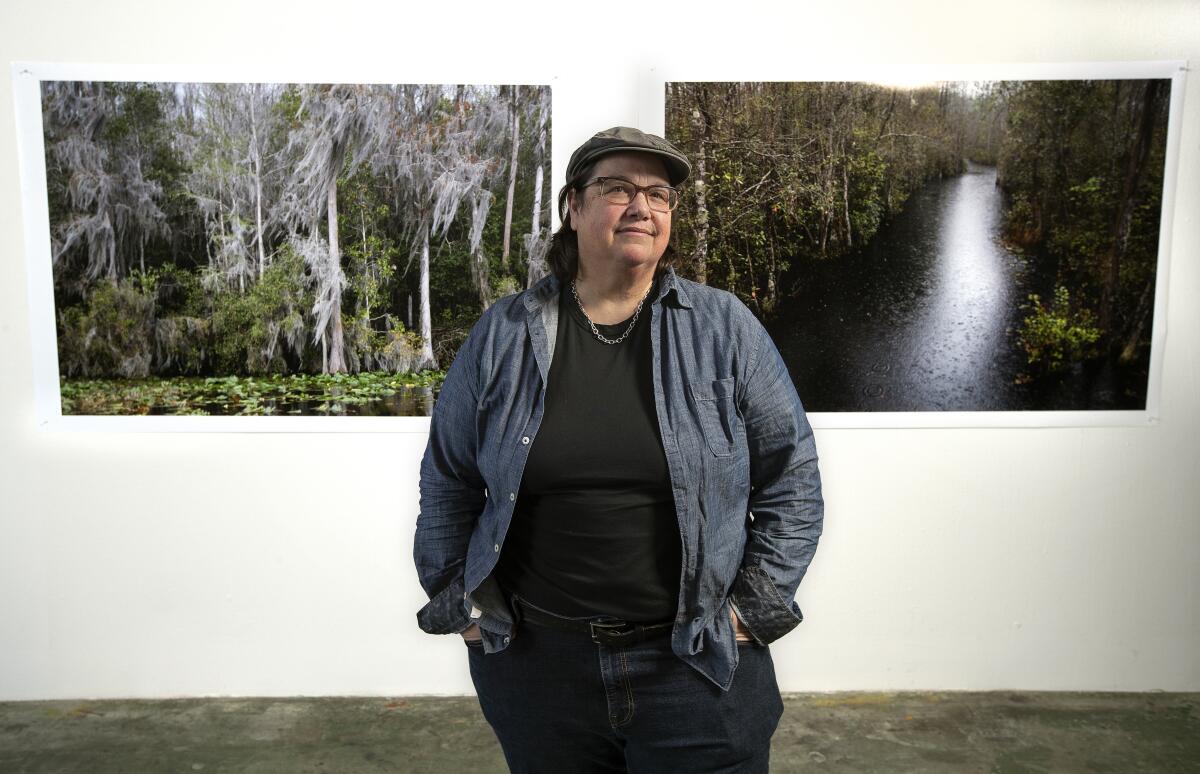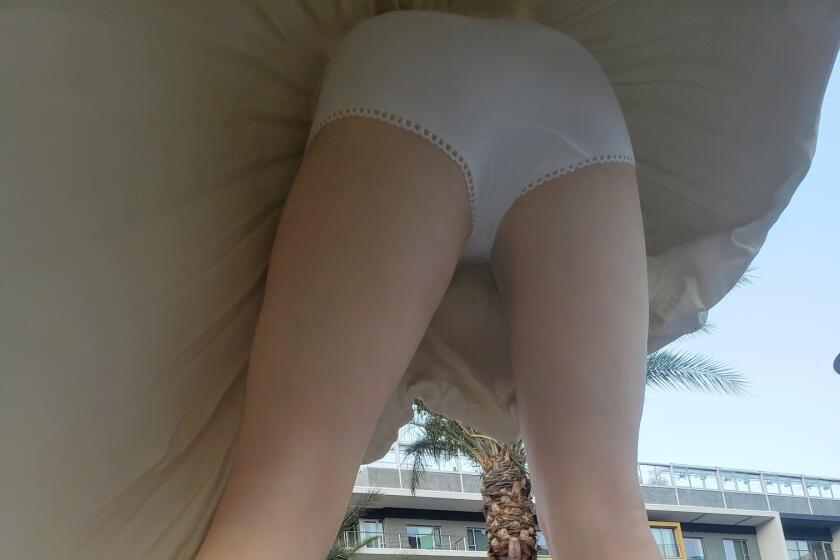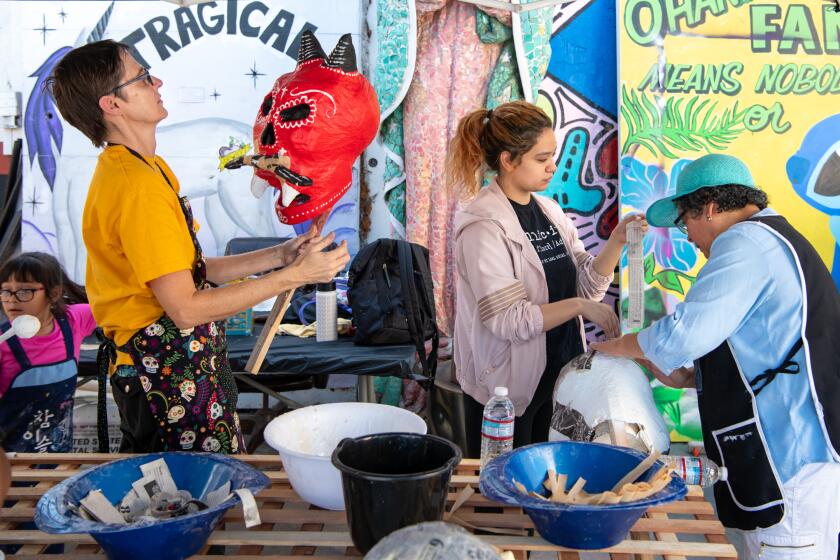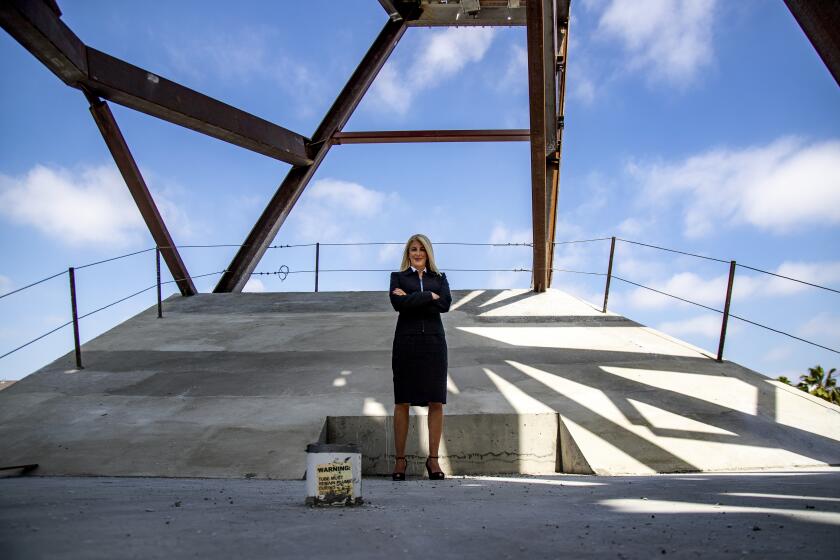Catherine Opie’s plan to help UCLA art students graduate with way less debt

- Share via
Artist Catherine Opie, a UCLA professor of photography for 20 years, has big ideas for the university’s art department. Among them: Reduce student debt and lower economic barriers to education.
It’s a vision Opie is in a position to start realizing: UCLA has named her art department chair, it announced on Tuesday. She steps into the role Sept. 1, taking over for artist Andrea Fraser, who has led the department since January 2018.
In 2019, UCLA announced Opie as the university’s inaugural endowed chair in the art department, a position underwritten by a $2-million gift from philanthropists Lynda and Stewart Resnick. That role is an undergraduate and graduate teaching position. The departmental chair is the lead administrative position, working with faculty and staff to develop the academic curriculum, goals and priorities of the art department.
Opie’s commitment to educational access for all students is needed “now more than ever,” said Brett Steele, UCLA’s dean of the School of the Arts and Architecture.
“As the arts themselves evolve, particularly in this new world we find ourselves in and the focus that last year’s crisis placed on our needing to find ways to support all students, Cathy’s voice is vital,” he said, referring to inequities among students that were illuminated, in part, by the pandemic.
Opie, 60, is a renowned artist who has, for more than four decades, produced portraiture, landscapes and studio photography, in conceptual and documentary styles, delving into cultural and geographic identities. A new Phaidon monograph came out this month.
Misogyny is a root cause of homophobia, but a famously LGBTQ-friendly city has just raised a monument to it. The cognitive dissonance of #MeTooMarilyn
She plans to turn her artistic eye to the evolving art of photography as well as the post-COVID-19 educational landscape — but always with an emphasis on accessibility to arts education, she said in this edited conversation.
Why is accessibility such a key issue for you now?
We know that one of the biggest problems within our nation for young people is debt from education. We also know, through statistics and an enormous amount of research being done, that one of the fields that’s the hardest to go into in relationship to pay equity is the arts. So what is it for us to realize that students shouldn’t leave with an undergraduate degree and [significant debt]. Obviously people take loans. L.A. is an increasingly more expensive city to live in. There are other needs, basic human needs like food and shelter. We have issues at UCLA with students being hungry. Some students have been sleeping in their cars.
These are not just art department problems but larger university problems. But the more we can create UCLA as a public institution, especially the arts as being a vital part of the city of Los Angeles, that’s the goal. Can we get to the place where students are not stretched in order to have their dreams and their goals met through education?
The billionaire philanthropist donated $2.7 billion to 286 arts, educational and social justice organizations. Here are some of the SoCal recipients.
How do you plan to get there?
I would like to bring in at least $10 million in the next three years to UCLA to have ongoing security in scholarships. And then the more endowed professorships we can give create a kind of security, physically, in terms of hiring adjunct [faculty]. That’s another big thing — these adjunct professors, often they come in and they’re incredible and they teach a class here and there, but they don’t have medical insurance, they don’t have the same kind of access. So what does that kind of portion of equity mean right now and how can I, through philanthropy, create a better situation for not only the students but also the adjunct faculty at UCLA?
What are some of your other goals for the art department?
I was able to secure a gift, through the Resnicks, of endowing my position and also rebuilding the darkrooms for the kind of caliber of faculty that we have and the prominence of our program. So I want to continue to work on endowing positions. I want to continue to work on securing scholarships. And I want to continue to improve upon the facilities.
But there’s also something, in the last 20 years, that I’ve wanted to tackle: That is the south [hard sciences] and north [social sciences] campus divide. I really feel there is no reason for the UCLA hospital system not to embrace the arts. I would love to see an undergraduate gallery that has rotating exhibitions in the hospital. I would love to see wellness and art combined in relationship to a broader program such as the Cleveland Clinic has done and Kaiser Permanente is undertaking right now. Obviously we’re there to teach, so continuing the reputation of the department [is a goal]. But also, what can we do to create larger conversations about the arts at UCLA?
Are there issues specific to diversity, equity and inclusion that you hope to address?
We started a lot of that work this past year in terms of committee meetings, and we do have a [new] DEI officer. Being off campus this past year [while on sabbatical], I haven’t gone into those meetings yet. But I can tell you, just in terms of my teaching the last 20 years, it has been a very, very diverse program because we are UCLA and it’s a public institution.
It wasn’t within the faculty, but we’ve done an enormous amount to address that within the faculty over the past five years. Also, I want to talk to the other faculty — I haven’t been chair yet — and I want to know what their concerns are. Coming out of a pandemic, there might be other concerns I’m not aware of because I did have a sabbatical year. I think it’s about that kind of collectivity with the rest of the faculty in terms of setting an agenda for the next five years.
The past year has been especially challenging in education. What are your post-pandemic concerns for the art department?
The thing I’m most concerned about is the class of 2020 and not being able to have their thesis shows as graduate students. That is the culmination of one’s work in a grad program, to get to have a thesis show. So what can we do in relationship to those graduates that didn’t necessarily have the same kind of experience in being able to show their work to a public audience.
Has the disruption of the past year created any lasting changes in how art will be taught at UCLA?
I could see keeping certain aspects of what we learned from the pandemic. In-person lectures are always best with artists. But if you can get an artist from Europe to hop onto Zoom, and present their work and have a conversation with the grad students, I could see keeping that kind of idea of accessibility in the program. But we’re a real studio art program, we rely on our facilities and our studios — the students are makers. And again, depending on what background they come from, accessibility of facilities is everything in art.
The new Orange County Museum of Art designed by Morphosis is three-quarters built. New director Heidi Zuckerman gives us a glimpse at what’s ahead.
You’re opting not to pursue another term on the Museum of Contemporary Art board because of your new UCLA position. Why?
I’ve served on the MOCA board for eight years. I really value my relationship with the other trustees. But [considering] my goals of transparency and governance and what I believe, individually, I really feel that I can’t go to some of those people on the board, if I remain as a trustee, to ask them to think about UCLA. I don’t think it’s fair for me to be a trustee of an institution that also needs money, while remaining as a trustee, and asking certain members who have affiliations with UCLA to give gifts. I don’t think that’s good practice in terms of governance.
What’s the first order of business, the thing you’re most excited about?
The first order of business is to ask what has happened this past year in the pandemic and talk to each faculty member about what their dreams and goals are for the program. And then recalibrate those in terms of moving forward.
And philanthropy. I actually really enjoy raising money. I’ve been pretty good doing that at UCLA. I want to see if somehow we can actually get corporate sponsorship in relationship to equipment needs. This is how we open up culture, we actually support culture. Philanthropy shouldn’t always come from the super-rich. Philanthropy should be part of all of us, part of citizenship to a certain extent. One of the things that Obama did was he showed that philanthropy can be $2 from somebody. And I really believe in that. It’s so key not to leave college with enormous debt that then doesn’t allow you to move on.
More to Read
The biggest entertainment stories
Get our big stories about Hollywood, film, television, music, arts, culture and more right in your inbox as soon as they publish.
You may occasionally receive promotional content from the Los Angeles Times.














